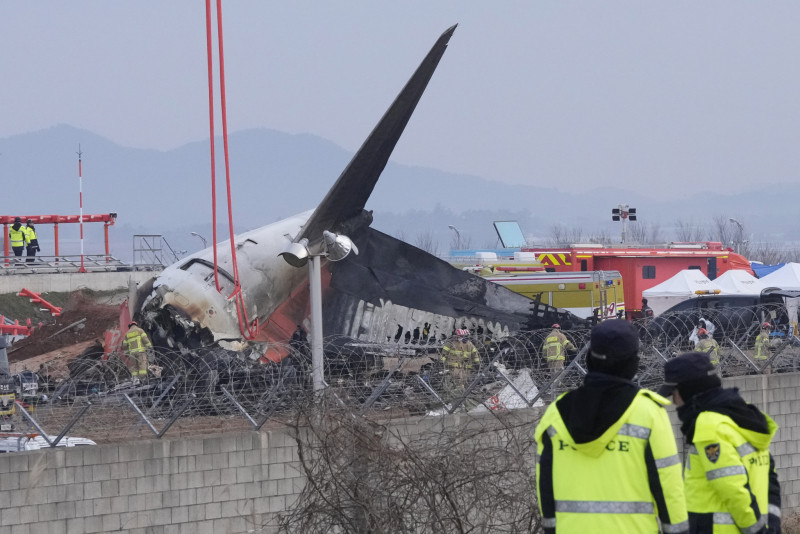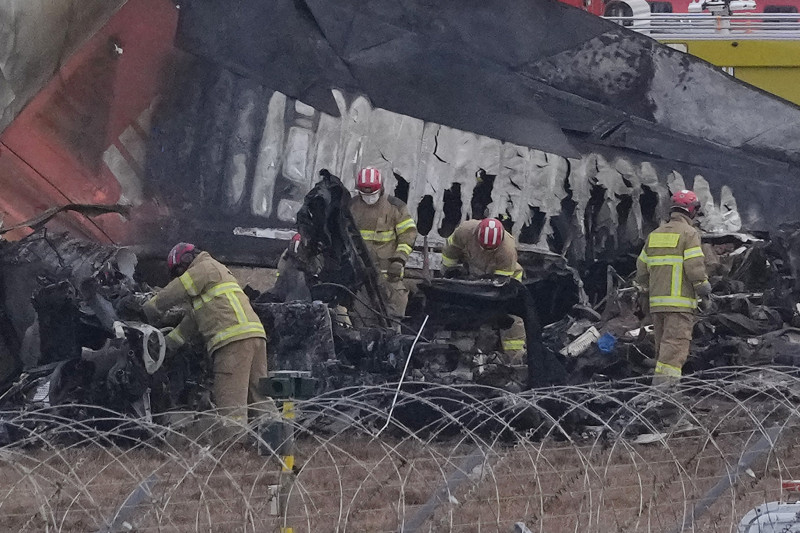141 of the 179 victims were identified – The causes of the tragedy are unclear – Questions about the wall that existed at the end of the runway
South Korea has declared seven days of mourning after Jeju Air Flight 2216 crash at Muan Airport where of the aircraft’s 181 passengers only two survived.
Flags are flying at half mast in the country, today Monday and at the same time altars will be erected in memory of the victims throughout the country.
THE President of South Korea, Choi Sang-mok is flying to the crash site in southwestern Muan where a memorial service will be held while yesterday Sunday relatives of the passengers who lost their lives gathered at the international airport where the tragedy occurred.
On the runway of the airport, near the damaged fuselage, the stench of kerosene is still present as well as scattered seats, suitcases and pieces of metal.
According to South Korea’s Ministry of Infrastructure, 141 of the 179 victims have now been identifiedwith DNA analysis or fingerprint collection. In fact, 165 bodies were transferred to a morgue temporarily.
Regarding the causes of the crash of the aircraft still remains unclear, with many questions for experts to answer. Officials have pointed to a bird strike as one of the possible causes of the tragedy. A bird strike warning was also issued by the control tower just minutes before the crash however, two minutes later the aircraft made a landing.
At the same time, South Korean authorities are planning “special inspections” of all Boeing 737-800s in use in the country as the fact that the aircraft’s wheels did not open also raises questions.
“101 B737-800 series aircraft are currently in service in South Korea. Accordingly, we are considering plans to conduct a special inspection on B737-800 aircraft,” said Joo Jong-wan, head of the civil aviation office at South Korea’s transport ministry.
“Why didn’t the firefighters put foam on the runway? Why weren’t they present when the plane went down? And why did the aircraft fall so far down the runway? And why was there a brick wall at the end of the corridor?’ said Airline News editor Jeffrey Thomas.
Because there was an obstacle at the end of the corridor
But experts who have reviewed footage from the time of the crash show the plane making an emergency landing but then hitting a wall – raising questions about whether airport construction played a role in the tragedy.
Kim Kwang-il, Professor of Aeronautical Science at Silla University and a former pilot speaking to AFP pointed out that there should not be “a fixed structure” in this area at all.
“Normally, at the end of a runway, there is no such solid barrier – it is against international aviation safety standards,” he said.
“The structure in question caused the crash of the aircraft and the fire. Outside the airport, there are usually only fences, which are soft and do not cause significant damage. The plane could glide more and stop naturally. The unnecessary structure is very sad,” he stressed.
Aviation safety record
Agence France-Presse points out that South Korea’s airline industry has a solid record for the safety of its aircraft, and the Jeju Air plane tragedy was the first fatal accident for the company.
On August 12, 2007, strong winds caused a Jeju Air-operated Bombardier Q400 carrying 74 passengers to run off the runway at Busan-Gimhae Airport. Dozens of people were injured.
Before Sunday’s tragedy, the deadliest plane crash on South Korean soil occurred on April 15, 2002, when an Air China Boeing 767 traveling from Beijing crashed into a hill near Busan-Gimhae, killing 129 people. lose their lives.
South Korea’s most recent fatal plane crash occurred in San Francisco, California on July 6, 2013. An Asiana Airlines Boeing 777 encountered trouble on landing, killing three and injuring 182.
The deadliest disaster involving a South Korean airline dates back to September 1, 1983, when a Soviet fighter jet shot down a Boeing 747, which Moscow claimed was mistaken for a spy plane. All 23 crew members and 246 passengers on board the Korean Air flight – a flight from New York to Seoul via Anchorage, Alaska – were killed.
Source :Skai
With a wealth of experience honed over 4+ years in journalism, I bring a seasoned voice to the world of news. Currently, I work as a freelance writer and editor, always seeking new opportunities to tell compelling stories in the field of world news.













